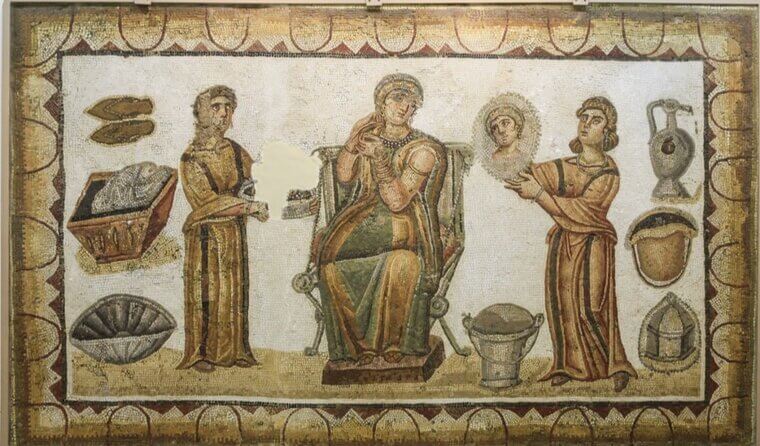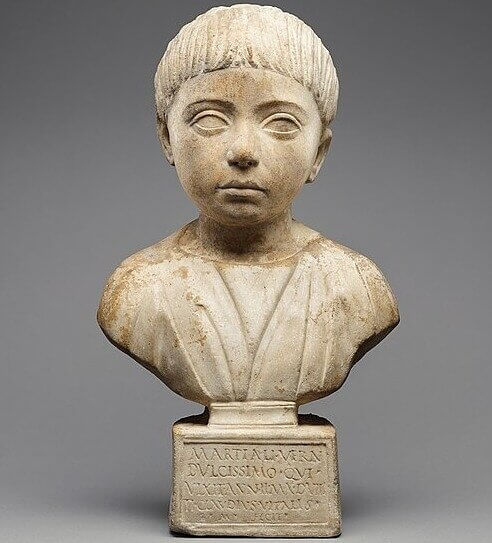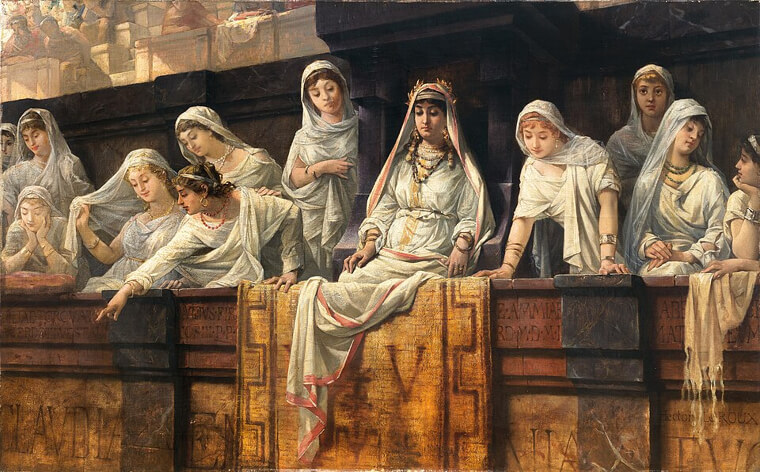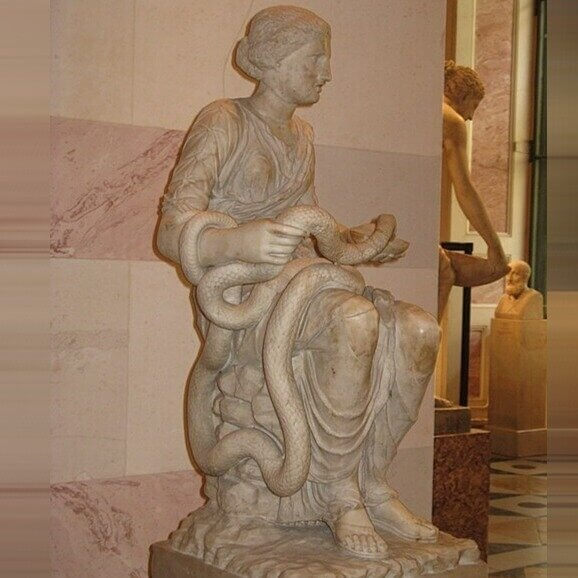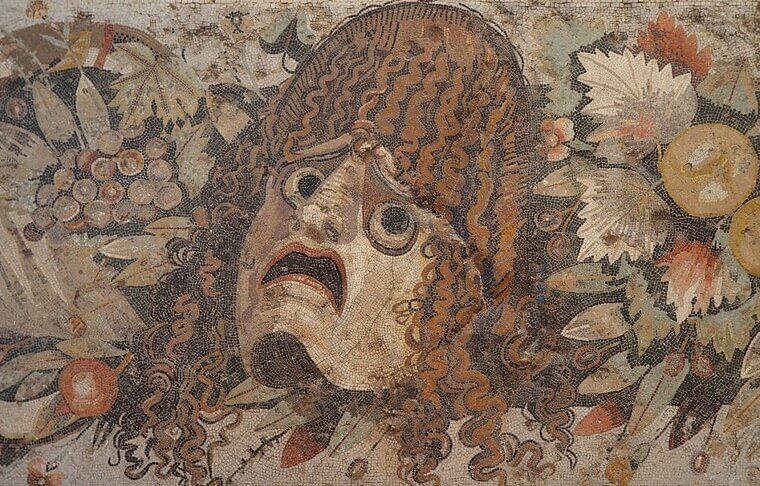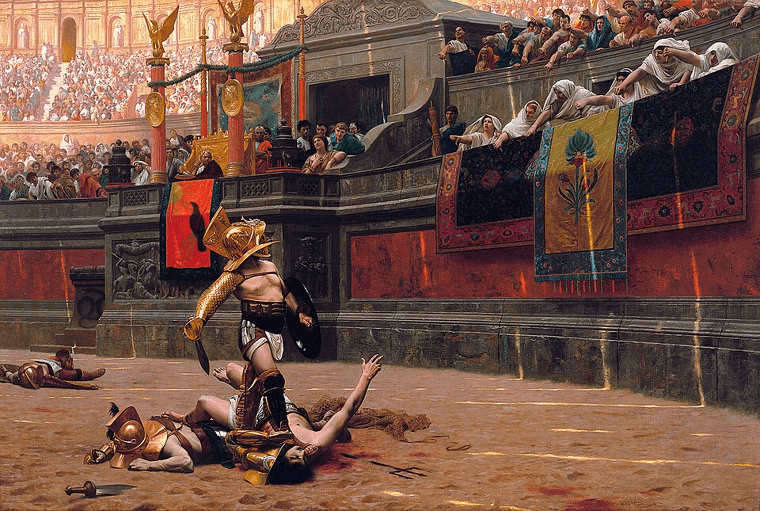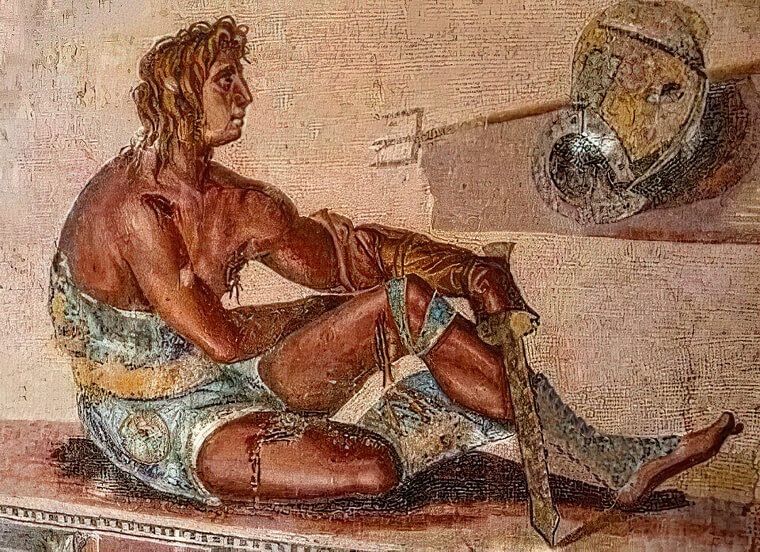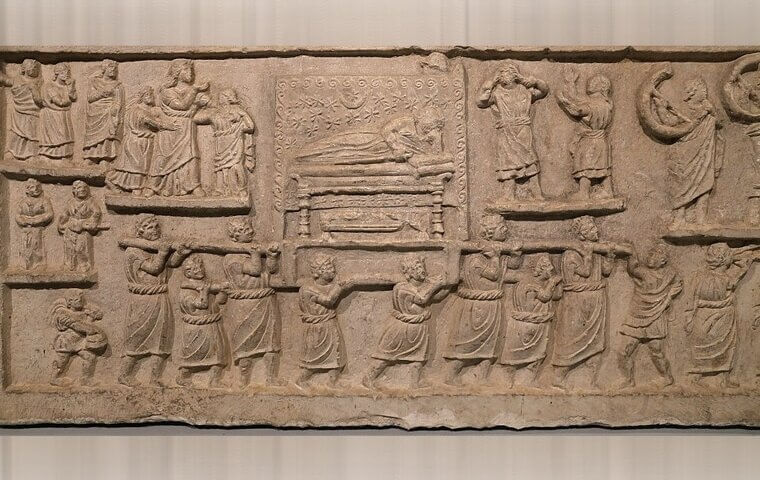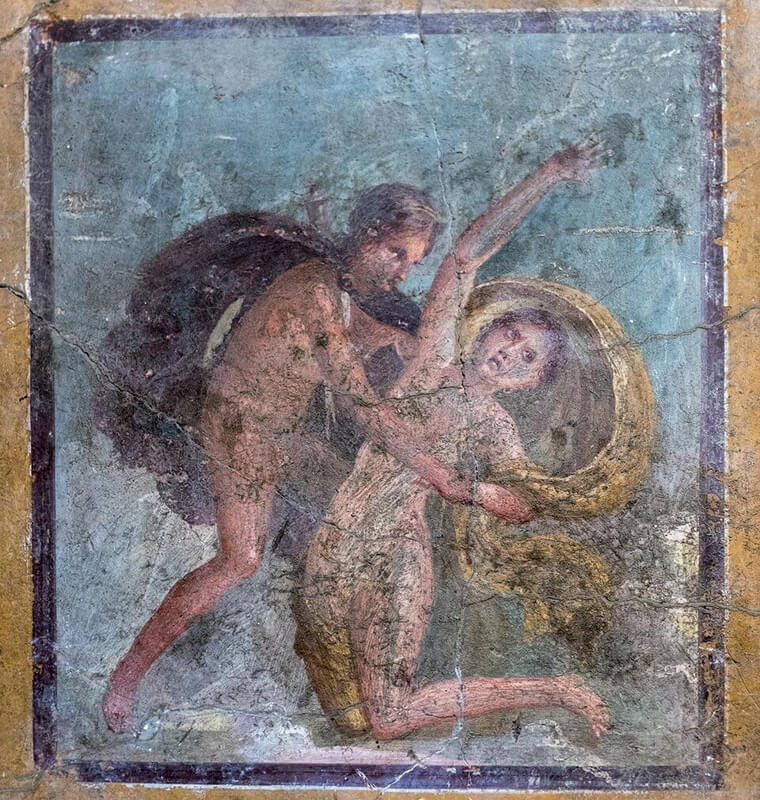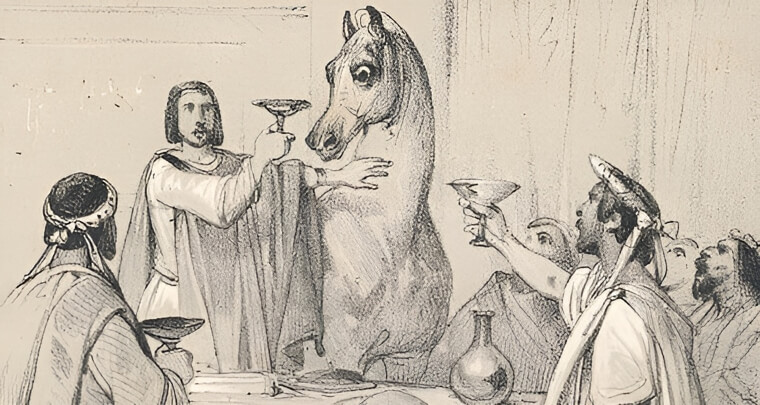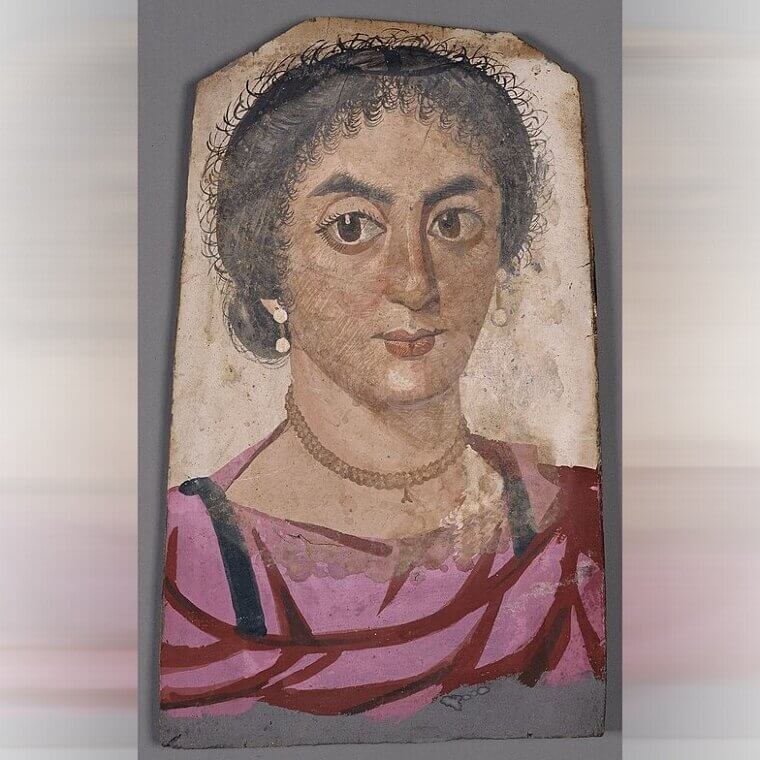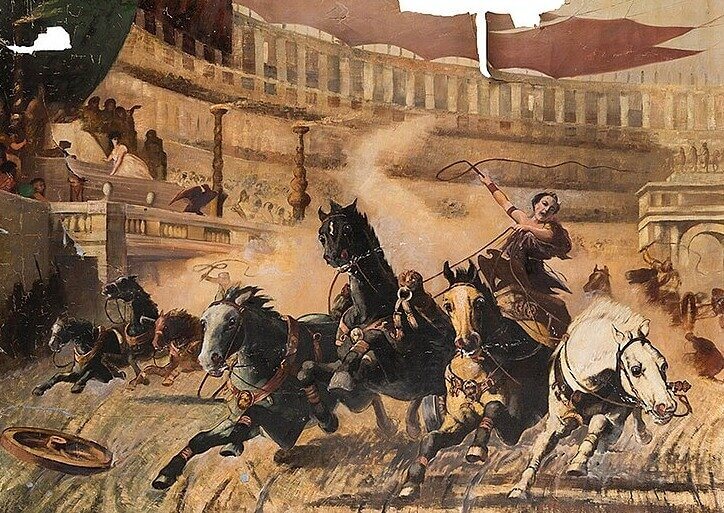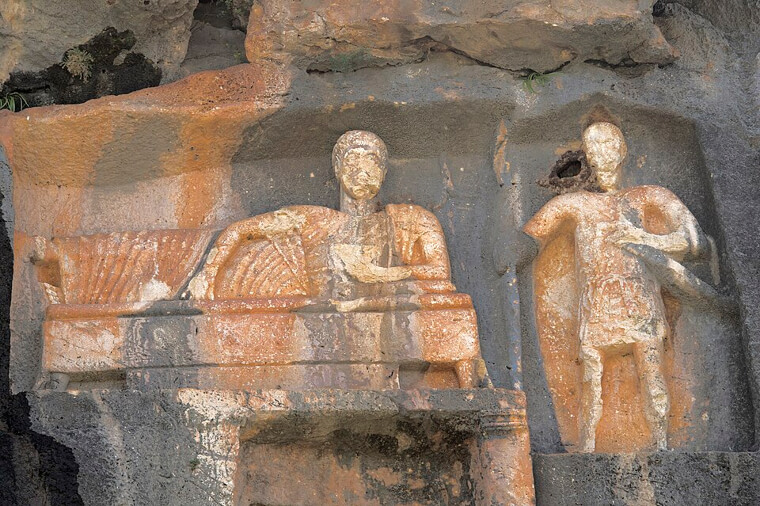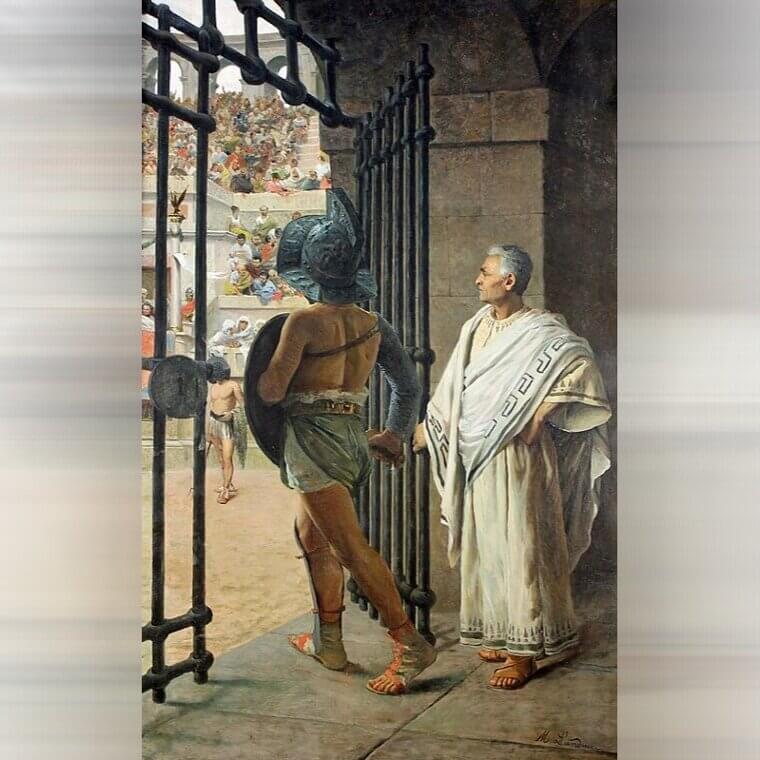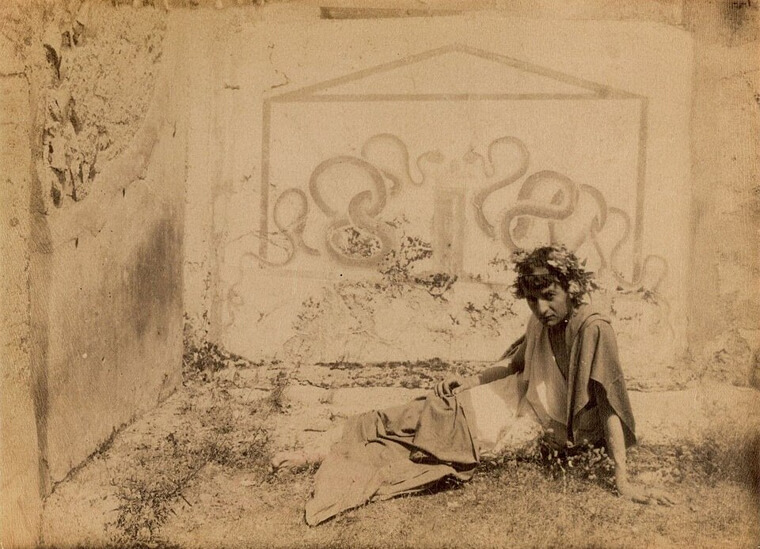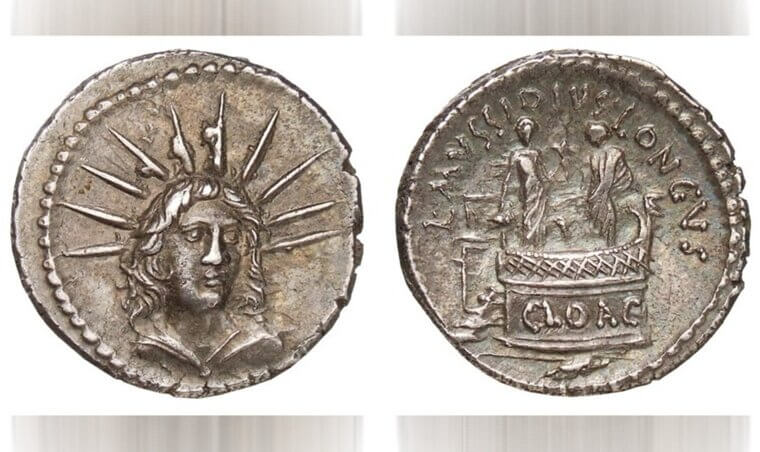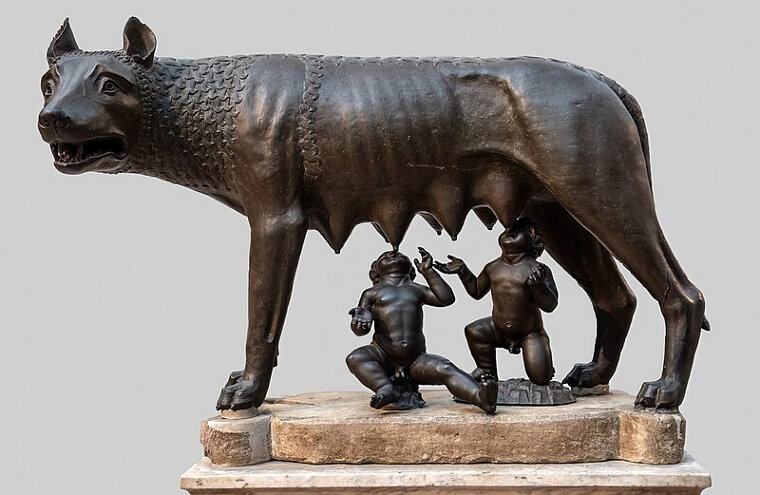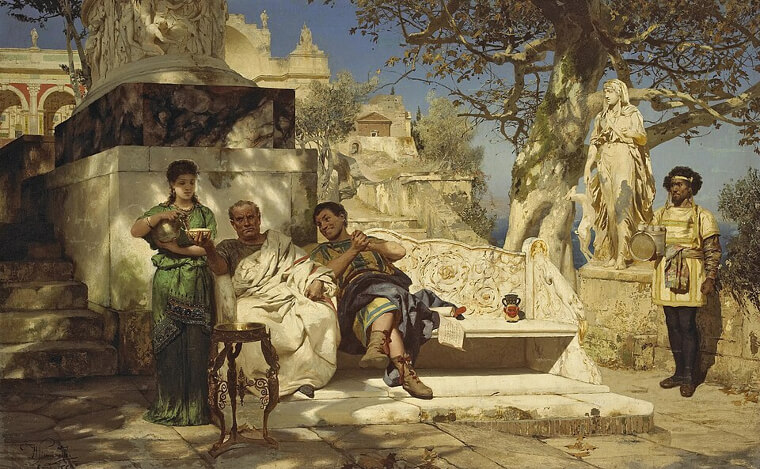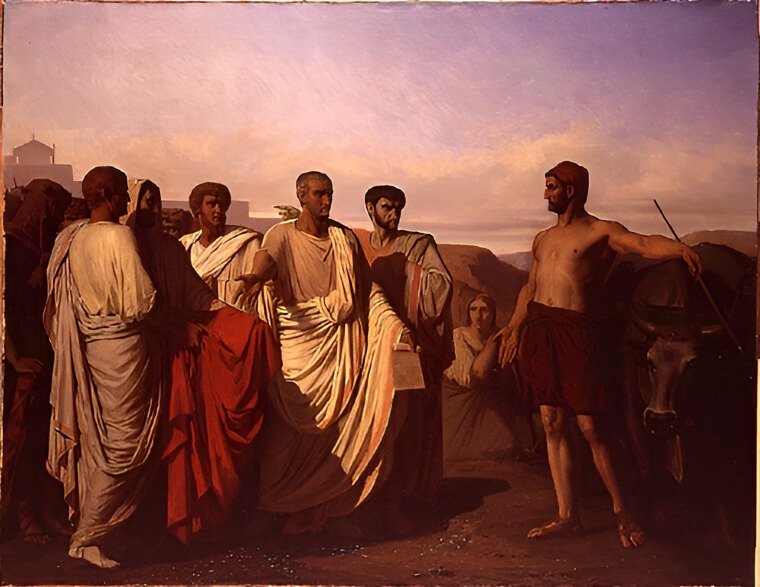Urine Was a Valuable Commodity Used for Laundry and Other Things
In Ancient Rome, even bathroom breaks came at a cost. Emperor Nero introduced what was known as vectigal urinae - a tax on urine that required people to pay to use public toilets. But the Romans didn’t let this urine go to waste, and both public and private urinals were drained into collection pools and gathered for practical uses like tanning. This helped remove hair from animal pelts, making leather production more efficient.
Urine was also a key ingredient in the Roman laundry and was used as a natural bleaching and cleaning agent thanks to its high ammonia content. Talk about a bizarre commodity!
The Ancient Romans Had Crepitus, The God of the Flatulence
Crepitus is one of the lesser-known and talked-about gods of Rome, and for good reason! Crepitus was the god of flatulence, often associated with bodily functions that most would rather ignore - our stomachs and all its troubles. He wasn’t as widely worshipped, of course, but later writings do mention him, mostly as a joke. And, his existence shows that Romans had a funny and practical view of everyday life, even when things were tough.
Even though Crepitus wasn’t an important god, he reminds us that the Romans didn’t ignore life’s messy parts - they embraced them. He adds a fun and unusual twist to Roman mythology.
Parents Selling Their Own Children Was Normal
Roman fathers had a lot of control over their kids and even had the right to sell them into slavery if they wanted to. But here’s the thing - it wasn’t always permanent and worked more like a lease where the child had to be returned after some time. It was pretty common practice, especially if a family needed money. And while it does sound a bit harsh, back then it was just another way to survive and manage household finances.
Thankfully, though, there were limits or rules. A father could only sell his child into slavery three times. If he tried just once more, the child was considered emancipated.
They Often Ate This Fish Because It Caused Hallucinations
Believe it or not, some ancient Romans got a bit buzzed by eating certain types of fish. One of the main culprits was the sarpa salpa, a type of sea bream that, when consumed, caused hallucinations. Some people ate it on purpose for the strange effects, while others got a bit of an unexpected surprise after a seafood feast. The effects of this rather strange snack could last for days, making it both a bizarre and risky way to experience a different kind of “trip.”
This might sound like an ancient party trick, but it wasn’t always fun. Some people experienced terrifying visions, and there are even modern cases of accidental fish-induced hallucinations.
Everyone Shared the Same Sponge Stick in the Public Restrooms
Personal hygiene was not a big thing in ancient Rome, and the Roman's bathroom habits prove it! Instead of using toilet paper, they used a sponge on a stick - called a tersorium - to clean up after using the bathroom. Doesn’t sound too bad, right? But wait, it gets worse because this wasn’t just a personal sponge! It was communal and was shared in public restrooms, with everyone using the same one. They simply rinsed the sponge in a bucket of salt water and vinegar, ready for the next person to use it.
As you can imagine, this wasn’t the most sanitary system. With so many people using the communal sponge, diseases were easily spread. Ancient Rome may have been advanced in many ways, but their bathroom practices? Not so much!
Flamingo Tongue Was Considered a Delicacy
Every nation and its people have their own delicacies, and in Ancient Rome, this just happened to be flamingo tongue; yes, you read that correctly, the tongue of a flamingo! Wealthier Romans believed that it had amazing flavor, and even Pliny the Elder wrote about how popular it was in the Encyclopedia of Natural History. But it gets even more bizarre - they didn’t just stop at the tongue, and whole flamingoes were cooked and served at lavish feasts.
A cookbook from that time even included a detailed recipe explaining how to boil the bird with salt, dill, coriander, leeks, and vinegar, then finish it off with grape juice for extra color and taste.
The Vestal Virgins Were Chosen Between the Ages of 6 and 10 and Had to Serve for 30 Years
The Vestal Virgins of Ancient Rome were priestesses dedicated solely to the goddess Vesta, who represented the hearth. There were usually four to six Vestal Virgins at a time, and they had important roles like keeping the sacred fire burning, caring for sacred objects, and leading ceremonies for Vesta. They were chosen at a young age, around six and ten years old, had to serve for no less than 30 years, and were expected to remain pure and dedicated to their duties.
For those who broke the rules, there were some pretty horrific consequences that involved molten lead, beatings, and, in severe cases, death. What a crazy fact!
Ancient Skincare: Gladiator Sweat Was Sold to Wealthy Women as a Face Cream
In Ancient Rome, not even a drop of any bodily fluid went to waste. We know that urine was used for cleaning, but did you know that gladiator sweat was also collected and sold? Wealthy Roman women would buy small vials of this sweat, using it as a type of face cream. Vendors would stand outside the arena and sell vials of this popular “beauty trend” to waiting patrons.
The sweat was scraped off with a tool called a strigil, which removed the grime from famous gladiators, bottled it up, and sold it to the high-status women who could afford the luxury treatment.
Being Left-Handed Was a Sin
Being left-handed was seen as a serious problem in Ancient Rome, with left-handed people often looked down on and considered unlucky or even dishonest by those who were right-handed. They were also seen as suspicious and treated wholly unfairly because of it. Despite some myths about left-handed people being revered or held in high regard, the prejudice against these people was so strong that they were not respected in Ancient Rome.
As a result, people wore their wedding rings on their left hand’s third finger to avoid any association with the “lefties” and also the “sin” of being left-handed.
Ancient Romans Initially Thought the Early Christians Were Cannibals
Early Christians in Ancient Rome were often seen as atheists because they refused to worship the Roman Gods. But that wasn’t the only thing the Romans misunderstood about them. They also believed that Christians were cannibals! This strange belief came about from the Christian practice of communion that sees worshippers symbolically eating “the body of Christ” and drinking his blood. It caused such a stir that the early Christians had to come up with a way to clear up the misunderstanding.
They invited the Roman officials to watch their ceremonies and see that they weren’t actually eating people or drinking blood and that it was more a symbol than anything else.
They Loved Their Pets and Kept Everything From Dogs and Cats to Snakes and Monkeys at Home
Almost everyone loves pets, right? Well, the Romans were the same and loved having pets. In fact, they were even more open about their affection for animals than we are now. Dogs and cats were among the popular choices, but some Romans took it a step further by keeping snakes, birds, apes, and even monkeys as pets. And for some, their pets were more like a part of the family.
This was seen by Alexander the False Prophet, who visited Macedonia and saw tame, gentle snakes being kept by the women and children. The snakes even drank milk like children do!
The Life Expectancy of a Roman Was 25-40 Years
It’s no secret that Ancient Rome was considered advanced, especially when it comes to their technology. But, when it came to their living conditions, they were far from clean, and most people in the city lived in unsanitary conditions. Many historians believed that this was one of the biggest contributing factors to the Romans having a life expectancy of around 25 to 40 years. This isn’t quite accurate, though, and only reflects the high number of deaths in childhood and also during birth.
Once you made it past childhood in Rome and survived the dangers of both war for men and childbirth for women, you had a good chance of living a much longer life.
Romans Believed Drinking a Dead Gladiator's Blood or Eating Its Liver Cured Epilepsy
Ancient Romans really believed in some strange health remedies! They did things like brushing their teeth with urine and sharing sponges in public bathrooms. But, one of the more unusual beliefs was that drinking a gladiator’s blood or eating their liver could cure epilepsy. We have to agree that this is one of the more bizarre facts that we rather wish we didn’t know at all! People thought the blood could cleanse the soul.
It was also believed to help with illnesses, and the gladiator blood was even sold while still warm right after they died in the arena.
There Were Female Gladiators Called Gladiatrices
Being a gladiator wasn’t just for the men of Rome, there were some female gladiators too. Sadly, many female slaves were forced to fight in the games, with a few volunteering for the more violent battles. No one really knows when women first started fighting in the arenas, but by the time the first century A.D. rolled around, women were a regular part of the gladiator games, and fought just like the men.
A marble relief, dated to be from the 2nd century, shows two women, Amazon and Achillia, fighting to a draw and showcasing their roles in these very popular gladiator games.
Audiences Determined the Faith of a Gladiator With a “Thumbs Down" or "thumbs Up"
Many people think that when a gladiator was hurt or surrendered, the emperor decided their fate with a “thumbs up” or “thumbs down.” But, it was actually the crowd who decided, with the emperor and the arena games organizers following the lead of the crowd by listening for their boos and cheers. There are so many images that show emperors using the gesture, but some historians have shared some new insights into what this meant.
A “thumbs up” could have meant death, and mercy might have been shown with a closed fist, two fingers, or a waved handkerchief. Now we know the difference!
Soldiers Were Paid in Salt and Slaves Were Bought With Salt
As we know, most of the words we use today were derived from ancient times. And in the case of the word “salary,” it came from the Latin word salarium, which is connected to salt. In Ancient Rome, the soldiers were rumored to be paid in salt. Salt was an important trade item in those times, making it a valuable form of payment or currency. It is also believed that slaves were bought with salt.
Salt was incredibly valuable in Ancient Rome, and it is said that the more you were worth, the more salt you earned - hence the term salary.
Crying at Funerals Was Banned Because Families Were Hiring Professional Mourners to Cry for Their Loved Ones
People typically cry at funerals, and that’s okay. But, in Ancient Rome, they had to ban crying at funerals. Sounds bizarre, right? Here’s why: Funerals in Rome often began with a procession through the streets. The more mourners there were, the more it showed how well-liked and important the person was in life. It was also a way for families to show off their loved one’s status. Some families would take this too far and hire professional mourners to cry and perform at these processions.
It became so common that it was eventually banned to stop people from faking their grief for the sake of showing off just how important their family member was.
Wealthy Wives Took 3-Day Vacations at Least Once a Year to Avoid Becoming Their Husband's Legal Property
In the Roman Empire, wives had to be so careful not to stay in their homes for too long. The “usucapio” laws of the time stated that if someone held onto something for a full year, it became legally theirs. This rule even applied to people, namely wives. To avoid becoming their husband’s property, many women left their homes for up to three days in a row to escape the law.
Thankfully, some women still had some freedom to manage their lives and prevent being trapped by these seemingly archaic laws. Thank goodness we don’t live by these laws today!
Disrespecting Your Elders Could Lead to Death
Do you remember your parents telling you to respect your elders? This is one of those rules that has been passed down for centuries, but in the Roman Empire, failing to do so could be deadly! Simply disrespecting your elders would result in severe punishment. The very worst offense was parricide, which is killing a parent or close relative. This crime was considered so serious that it led to one of the most terrifying punishments in history.
Anyone guilty of parricide would face what was known as Poena Cullei, a graphic and brutal execution method that you would need to research yourself to believe.
Husbands Could Cheat, but Cheating Wives Were Publicly Caged and Shamed
Cheating was a painful issue, even in Ancient Rome. But, the punishment wasn’t the same for men and women. If a man cheated on his wife, she had no choice but to cry and endure it. But, if the roles were reversed, and a woman cheated on her husband, the consequences would be so much worse for the woman, and she would have no choice but to face the consequences and all that came with it.
In some cases, the husband would lock up his wife and her lover, call people to see the affair, and announce all the details before he could divorce her.
Same-Sex Marriages Weren't Unheard of and Even Emperor Nero Married Two Men
In the Roman Empire, same-gender marriages might not have seemed too unusual. Emperor Nero, who ruled for 13 years, married two men during his time of power. One of these marriages happened during the Saturnalia festival when Nero married a freedman named Pythagoras. But, interestingly enough, Nero played the wife in this ahead-of-its-time ceremony. Sure, Nero had wives, but he later murdered one and married a young boy instead.
Nero married Sporus, who he later went on to castrate to make the boy appear more womanlike. Seems the Romans were more forward-thinking than we initially thought.
Emperor Gaius Caligula Was Obsessed With His Horse, Giving It a Marble Stall and Its Own House
Romans loved their pets. And Emperor Gaius Caligula was so fond of his horse, Incitatus, that he wanted to make him senator. He pampered Incitatus like royalty, giving him a stall made of marble, an ivory manger, and even his own house to live in. This is all according to ancient historian Suetonius, who made these claims about Caligula and his beloved horse. Whether or not we can believe it is another story.
The horse was said to have a jeweled collar and dined on oats mixed with gold flakes. Oh, to be a horse in Emperor Gaius Caligula’s care!
They Invented the Shopping Mall
It seems that we have the Ancient Romans to thank for the invention of the shopping mall. Trajan’s market is believed to be the very first shopping mall in the world and was built by architect Apollodorus of Damascus between 100 and 110 AD. It was located near the Colosseum, and was an impressive complex home to shopping areas, shops, and even apartments. Over time, more levels were added for living spaces, more stores, and even social spots.
Today, sadly, the market is mostly in ruins and has been like this for many centuries. Nonetheless, we thank the Romans for their contributions to our shopping addictions.
Anyone Struck by Lightning Was Looked Down on
Ancient Romans held some rather different beliefs, and many of these seem a little kooky to us today. One was that being struck by lightning was a direct sign from the god Jupiter that one was not favored. If someone were struck by lightning, no one would help. This made it especially hard for those who had to witness their friends and family being struck, as they couldn’t even give them a proper burial.
The Romans believed that burying the person would anger Jupiter, and anyone who tried would face punishment and possibly end up being sacrificed to Jupiter.
The Color Purple Symbolized Wealth and Power so Only Certain People Were Allowed to Wear It
Most cultures and civilizations have their beliefs about certain colors symbolizing wealth and power. And for Ancient Romans, this was the color purple. Only emperors and high-ranking officials were allowed to wear purple togas, and it was illegal for anyone from the lower classes to even think of wearing the color. This formed a part of the sumptuary laws that governed how Romans dressed, interacted, and lived and helped Romans easily identify someone’s social status.
It might sound bizarre, but it was a clever way to keep things organized, so no one wasted time being polite to someone they thought was beneath them.
The Most Popular Sport Was Chariot Racing, Not Gladiator Fights
For many, the first thing that comes to mind when you think of Ancient Rome is the gladiators, right? And while this was one of the favorite sports among the Romans, it wasn’t the most popular. Many people found the violence overwhelming, with the sport drawing in massive crowds all vying for their chance to see the action. The real fan favorite, however, is something that will no doubt surprise you.
Chariot racing actually attracted more spectators than gladiator battles. The Circus Maximus, where chariot races took place, could fit 250,000 fans. That’s pretty impressive!
High-Class Roman Men Ate Every Meal Reclined on a Couch-Bed
Meal time in Ancient Rome was a bit different than you would expect. For the wealthier men, this included eating while lying down rather than sitting at a table. They would recline on couches and eat with their hands, making breakfast, lunch, and dinner a comfortable and relaxed affair. Sounds like heaven, right? Sadly, women were usually excluded from these lavish meals, but over time, upper-class women were allowed to join in and eat while reclining.
This is one of the more bizarre practices that displayed the Roman’s wealth and social status. Anyone else wish that we could go back to those days?
Gladiators Were the Celebrities of the Roman Empire
Not everyone who fought in the gladiatorial arena was a true gladiator, and many were slaves and prisoners forced into the fight by their masters. True gladiators were the skilled fighters who became popular - almost like the celebrities we know and love today. Just like today’s athletes, Roman children would play with figurines of their favorite gladiators and pretend to fight among their friends, and sometimes dress up as them, too.
The true gladiators were also adored by women who would wear jewelry soaked in their blood or use their sweat in cosmetics and other beauty trends of the time.
They Fought in the Longest War in History - It Lasted Over 700 Years
Ancient Rome claims the title for the longest war in history—the Roman-Persian Wars, which lasted around 721 years! The Roman Empire often engaged in battle with the Parthian and, later, the Sasanian Persian empires. But despite this ongoing conflict, the Roman Empire stayed strong for much of the time. The wars started in 66 BC and lasted until around 628 AD when the Arab Muslim Conquests brought the conflict to an end.
Sadly, the wars drained much of the region's resources and also led to many casualties. Makes you wonder what other titles Rome holds, doesn’t it?
The Link Between Saturnalia and Christmas
There are so many theories as to where Christmas first originated. But what you might not know is that many of the more modern Christmas traditions, like decorating and exchanging gifts, came from Saturnalia, a Roman festival held in mid-December to honor Saturn, the god of agriculture. The festival lasted the whole week, starting on December 17th, and work would simply come to a halt with people fully enjoying the holiday season.
Many Romans decorated their homes with wreaths and other greenery, and some even dressed up. Slaves were also given a break from work. It was one of the grandest celebrations in ancient times.
The Word “Salad” Has Its Roots in Ancient Rome
Have you ever considered the origin of the words we use today? Did you know that the word “salad” has its roots in Rome? The Romans used to sprinkle salt on their vegetables and leafy greens to give them more flavor, and over time, these salted foods became known as salads. To the Romans, salt wasn’t just a seasoning; it played a key role in trade and daily life.
In fact, one of the busiest roads in Rome was the Via Salaria, a route traveled by soldiers and merchants bringing salt to Rome from the salt pans in Ostia.
The Sewer Goddess, Cloacina
Ancient Romans had a god for pretty much everything, and Cloacina was the goddess who looked after the drains and sewers in Rome. She was in charge of the Cloaca Maxima, the city’s main sewage system. She was originally part of Etruscan mythology but was later connected with Venus by the Romans. It’s a lot to take in and understand, but these gods were revered for their protection and safekeeping of the Romans.
Not only did Cloacina protect the sewers, but over time, she also became the goddess of marriage, cleanliness, and even filth. A shrine to honor her was built above the entrance to the Cloaca Maxima.
The Founders of Rome
Ancient Greek myths tell us that Rome was founded on April 21st, 753 BCE, by twin brothers Romulus and Remus, the sons of Rhea Silvia and the god Mars. They were ordered to kill their grandfather and were thrown into the Tiber River as punishment. But, they were saved by a she-wolf and later discovered by a herdsman who raised the boys. When they grew up, the twins killed King Amuliious and decided to start their own city.
But, coming up with a name for this city would lead to tragedy. After a fight, Romulus killed Remus and named the city Rome after himself.
Ancient Rome Wasn’t as Big as We Thought It Was
If you read anything about Rome, you are led to think that the Roman Empire was a huge empire that ruled much of Europe. But it was only the 28th largest empire in history and covered only 12% of the world’s population in its heyday. Even though the Roman Empire wasn’t as big as we thought it was, it had a profound influence on the history we learned about growing up.
Rome's history lasted for centuries despite its relatively small size compared to the other empires and civilizations that made the world what it is today.
Romans Considered the Early Christians to Be Atheists
The Roman Empire had a wide range of gods and goddesses, but some people followed early Christianity. Strangely, the Romans saw these people as atheists because they didn’t worship the traditional Pagan gods. Their refusal to honor the pagan gods was not the only reason they were labeled as atheists. It was much more than that, and the Romans just refused to accept them for what they were, rather labeling them as outsiders.
Early Christians didn’t have temples, priests, or organized practices, which made them outsiders in Roman society, often facing many rumors and extreme isolation.
A Dense Population
The Roman Empire might only have been the 28th largest empire in history, but it was home to a rather surprising number of people. At its peak, it spanned an impressive 4.4 million square miles and was home to around 57 million people living within its borders. It was incredibly densely populated! And while it doesn’t match the population density of, say, modern New York City, the population of Ancient Rome was very high for its size.
This makes it one of the most densely populated empires of its time and possibly just one of the reasons why it is so revered in history books today.
Income Inequality at Its Finest
Economic inequality has always been a thing, but in Ancient Rome, it was better than it is in America today. The top one percent in Rome controlled only about 16% of the wealth, compared to 40% controlled by the wealthiest in America today. This allowed for a more balanced distribution that helped the empire grow. Over time, however, the gap between the rich and the poor widened, playing a big role in the fall of the Roman Republic, which led to Julius Caesar’s rise to power.
This growing inequality eventually led to major political changes, which forever changed Rome and served as a stark reminder of the effects of inequality on citizens.
The Slaves of Rome
Slavery is all but abolished around the world today, but it was a key part of the economy in Ancient Rome. Historians estimate that enslaved people made up about 10 to 15% of the population, and it was most common between the Second Punic War and the 4th century CE. Slaves came from many different backgrounds and were often captured in war or bought by pirates. But unlike modern slavery, it wasn’t based on race.
Some people even sold their children into slavery to survive, making it a widespread practice throughout the Empire. Sadly many of these children were never reunited with their families.
The Statue of Liberty and Its Link to Rome
Do you know the real history behind the Statue of Liberty? In 23BC, the Roman goddess Libertas was honored with a temple on Aventine Hill. Centuries later, her image would inspire the Statue of Liberty, which stands proudly in her Roman gown on Liberty Island in New York Bay. But, what you might not know is that she is based on a Pagan goddess and not what you might have heard or read about.
Today, Libertas is featured on the currency of countries like Switzerland and the United States, including North Carolina. She represents freedom and is also depicted on the Great Seal of France.
Who Was Cincinnatus?
One of the more well-known stories that you might come across today is the story about a man from Ancient Rome named Cincinnatus. A humble farmer who only owned four acres of land, Cincinnatus was approached by a group of Romans who asked him to help defend the city from the Aequi, a neighboring tribe. Legend has it that Cincinnatus led the Roman army to victory in only 15 days. And when he was done, he simply returned to his peaceful life as a farmer.
Cincinnatus became the symbol of selflessness, choosing humble life over power despite his incredible success in battle. It just goes to show that not everything deserves pomp and ceremony.

